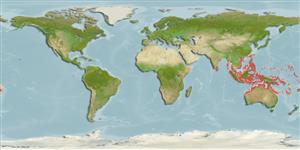>
Gobiiformes (Gobies) >
Gobiidae (Gobies) > Gobiinae
Etymology: Amblygobius: Greek, amblys = darkness + Latin gobius = gudgeon (Ref. 45335).
More on author: Bleeker.
Environment: milieu / climate zone / depth range / distribution range
Ökologie
seewasser; brackwasser riff-verbunden; tiefenbereich 3 - 25 m (Ref. 86942), usually 3 - 25 m (Ref. 27115). Tropical; 22°C - 30°C (Ref. 27115); 25°N - 24°S
Western Central Pacific: Philippines to New Caledonia, north to Yaeyama Islands, south to the Great Barrier Reef; throughout Micronesia.
Size / Gewicht / Alter
Maturity: Lm ? range ? - ? cm
Max length : 9.5 cm SL Männchen/unbestimmt; (Ref. 48637)
Rückenflossenstacheln (insgesamt): 7; Rückenflossenweichstrahlen (insgesamt): 14; Afterflossenstacheln 1; Afterflossenweichstrahlen: 14. Characterized by pale bluish-grey body color with pair of distinct orange stripes on head; sides with four faint orange stripes and diffuse cross-bars; base of caudal fin with orange spot;; first and second dorsal fin equal in height; rounded caudal fin; longitudinal scale series 55-60; predorsal scales 23-28; scales dorsally on opercle, absent on cheek; ctenoid body scales; cycloid scales on nape, abdomen, and opercle; depth of body 4.0-4.6 in SL (Ref. 90102).
Inhabits muddy bottoms of inshore bays and lagoons from about 3 to at least 20 m and uses a vertical, tube-like burrow of an unidentified invertebrate for refuge (Ref. 1602). Occurs in coastal and inner reefs on sand and rubble flats to about 20 meters depth (Ref. 48637). Feeds by sifting mouthfuls of sand to capture small invertebrates and organic matter (Ref. 1602).
Life cycle and mating behavior
Geschlechtsreife | Fortpflanzung | Ablaichen | Eier | Fecundity | Larven
Myers, R.F., 1991. Micronesian reef fishes. Second Ed. Coral Graphics, Barrigada, Guam. 298 p. (Ref. 1602)
IUCN Rote Liste Status (Ref. 130435)
Bedrohung für Menschen
Harmless
Nutzung durch Menschen
Aquarium: Kommerziell
Mehr Information
NamenSynonymeMetabolismusRäuberÖkotoxikologieFortpflanzungGeschlechtsreifeAblaichenSpawning aggregationFecundityEierEientwicklung
ReferenzenAquakulturAquakultur ProfilZuchtlinienGenetikElectrophoresesVererbbarkeitKrankheitenVerarbeitungNutrientsMass conversion
Tools
Zusatzinformationen
Download XML
Internet Quellen
Estimates based on models
Preferred temperature (Ref.
123201): 26.3 - 29, mean 28 °C (based on 646 cells).
Phylogenetic diversity index (Ref.
82804): PD
50 = 0.5000 [Uniqueness, from 0.5 = low to 2.0 = high].
Bayesian length-weight: a=0.00708 (0.00333 - 0.01504), b=3.09 (2.92 - 3.26), in cm total length, based on LWR estimates for this (Sub)family-body shape (Ref.
93245).
Trophic level (Ref.
69278): 2.7 ±0.24 se; based on food items.
Widerstandsfähigkeit (Ref.
120179): hoch, Verdopplung der Population dauert weniger als 15 Monate. (Preliminary K or Fecundity.).
Fishing Vulnerability (Ref.
59153): Low vulnerability (10 of 100).
Nutrients (Ref.
124155): Calcium = 141 [63, 273] mg/100g; Iron = 0.764 [0.378, 1.497] mg/100g; Protein = 18 [16, 20] %; Omega3 = 0.094 [0.040, 0.189] g/100g; Selenium = 23.1 [10.0, 60.8] μg/100g; VitaminA = 122 [30, 456] μg/100g; Zinc = 2.64 [1.69, 3.96] mg/100g (wet weight);
